Abstract
This work aims to propose an efficient MPS/FEM coupling method for the simulation of fluid–structure interaction (FSI), where the MPS and FEM are respectively employed to account for fluid flows and structural deformation. The main idea of our method is to develop a multi-scale multi-resolution MPS method for efficient fluid simulations in the context of MPS/FEM coupling. In the developed multi-scale MPS method, the fluid domain is discretized into particles of different resolutions before calculation, where particles close to the interest domain will be discretized into high resolution, while the rest are discretized into low resolution. A large particle interacting with small particles is divided into several small particles virtually, and weight functions are redefined to maintain the simulation stability. A bucket-sort-based algorithm is developed for the fast search of multi-resolution neighboring particles. The capacity of a newly proposed ghost cell boundary model is further enhanced, so as to accurately treat wall boundary problems with particles of different resolutions. On this basis, the multi-resolution MPS method is coupled with the FEM for FSI simulations. Finally, several numerical examples are conducted to demonstrate the accuracy and efficiency of the development method.
1. Introduction
In recent decades, an increasing interest has been devoted to investigating FSI phenomena that are very common in nature and industry [1,2,3]. Such phenomena are quite complicated, normally involving fluid flows, structural deformation, and interactions between them. Among the approaches used for FSI problems, the traditional analytical methods suffer from some limitations, as the interaction mechanism is complex and no proper governing equations can be used to account for all kinds of situations [4]. As a frequently used approach, experimental investigations are normally expensive, and attention needs to be paid to repeatability and environment factors that can affect experimental results, especially when it comes to large-scale problems [5,6]. In contrast, numerical simulations provide an effective and efficient way to reproduce complex FSI phenomena as well as to perform parametric studies for in-depth understanding of interaction mechanisms, and thus, this approach has attracted much attention in the scientific community.
Representative numerical algorithms involve grid-based FEM [7,8], where grids are used to discretize the domains of interest. This approach is relatively mature and has received widespread application in the FSI field. With the aid of such an approach, structural deformation can be well simulated, while it remains a challenging task to describe fluid flows undergoing large displacements. Another widely used approach in the FSI field is the immersed boundary-lattice Boltzmann method (IB-LBM) [9,10,11], which is based on the Boltzmann equation. It has some advantages, such as easy implementation, high parallelism, and effective treatment of complicated geometries. As for the mesh-free particle methods, e.g., the smooth particle hydrodynamics (SPH) [12,13,14,15,16] and the moving particle semi-implicit/simulation (MPS) method [17,18,19], the strong capability in solving fluid flows with free surfaces and large displacements has been well documented. However, this approach cannot simulate structural deformation and stress distribution well. In light of this, growing attempts have been made to develop grid–particle coupling methods (e.g., MPS/FEM [20,21,22,23,24] and SPH/FEM [25,26]) to take full use of their advantages, where the grid-based and particle-based methods are, respectively, adopted to account for structural deformation and fluid flows.
The MPS method was first proposed by Koshizuka et al. [17] in a semi-implicit form for the purpose of simulating the fragmentation of incompressible fluids, where the fluid domain was discretized into particles of the same radius and the movement of a given particle was influenced by neighboring particles via a kernel function. Shakibaeinia et al. [27] proposed a fully explicit MPS method for open-boundary free-surface flows, where the pressure was calculated explicitly. This work advocates the use of the explicit MPS method due to its simplicity and efficiency. Though the MPS method is promising in simulating fluid flows with free surfaces and large displacement, one of the key remaining issues concerns the low computational efficiency [28,29], which limits its applications in large-scale problems. The main reason is that the particle resolution must be sufficiently precise to yield satisfactory numerical results. In light of this issue, researchers have, therefore, developed and used various numerical techniques to boost the computational efficiency of the MPS method. Among them, a popular and effective strategy is to advocate the use of parallel computing, which can mainly be categorized into two groups, i.e., CPU-based [30,31] and GPU-based [32,33,34] schemes. In either kind of parallel scheme, the existing numerical method should be well parallelized for a better computational efficiency. In this case, the development of an easily parallelized numerical method is crucial for solving large-scale problems. In addition, it is worth noting that the speed-up of parallel computing is related to the computer hardware and programming techniques.
Currently, a large body of literature has focused on the development of multi-resolution particle methods, whose fundamental idea is to use fine particles to mimic fluid domains of interest and coarse particles for the rest of the fluid domains. A general treatment is that the fluid domain is locally refined to a high-resolution level by using a prescribed refinement criterion, such as a refinement domain, the number of neighbor particles, or some physical terms [35,36,37,38]. In this regard, particles that meet the refinement criterion are split, while those that flow out of the high-resolution domain are merged to coarse particles. The key points of such treatments are particle splitting/merging and information exchange between particles of different resolutions, which remains a non-trivial task for numerical simulations. On one hand, large particles that enter a high-resolution domain should be split into small particles within a few iterative steps and vice versa, which is time consuming and may cause numerical instability. On the other hand, it is quite difficult to guarantee momentum conservation during the exchange of kinematic information between particles of different resolutions. A possible remedy is to introduce a buffer zone between high- and low-resolution domains to reduce computational errors to a certain extent [39,40]. In addition to the aforementioned methods, the so-called adaptive particle refinement method [39,41,42,43] has recently been proposed, that is capable of moving high-resolution domains accordingly, making it easy to trace complex and unsteady flow problems. Beyond the above mentioned methods, the overlapping particle technique divides the flow domain into sub-domains of different resolution [29,44,45,46]. Each sub-domain is overlapped with another one, and both sub-domains can be calculated independently in the space and time domains, while the result of one sub-domain is regarded as the boundary condition of the other one. Inlet/outlet boundaries are usually set at the overlapped region to generate or erase particles and simulate the inflow and outflow of the fluid. By using this technique, particles only interact with other particles in the same sub-domain, which means that interactions between particles of different sizes are avoid. Except for the above-mentioned multi-resolution approaches, there are also some other algorithms. Lastiwka et al. [47] developed an inlet/outlet boundary for the SPH simulation, where the non-uniform particle distribution is preserved in the transverse direction. Oger et al. [48] proposed a spatially varying resolution method by using different smoothing lengths in the SPH method and simulated the wedge water entry problem. In this way, the number of fluid particles was reduced greatly. Shibata et al. [49] proposed an ellipsoidal particle model to reduce the number of particles and the computational cost. The size of each particle is the same in this model, whereas the particle distribution varies in different directions. Since the particles in the MPS method are merely calculation points, the ellipsoidal particles are virtual and have no clear surface.
Although the local refined multi-resolution particle method and the overlapping particle technique decrease the computational cost to some extent, they also have some drawbacks. For example, the number of particles in these methods is not constant, which is detrimental to the computation stability and not easy to extend to parallel computing. Furthermore, the generating and merging of particles are time consuming, especially when the interface of different-resolution regions is large. A simple yet efficient treatment that needs to be mentioned is to set fluid domains of interest as non-fixed, which can be called the multi-scale particle method, where particles of different resolutions are discretized prior to calculations [28,50,51]. In such a numerical treatment, particle sizes remain unchanged during simulations, and there are no splitting/merging processes. However, the mixing of different resolution particles remains a challenge of this method.
In the context of particle–grid combined FSI simulations, most of the current work adopts the uniform-resolution particle–grid coupling algorithms [23,24,25,52], where the particle size is limited to the desired accuracy and wall boundary conditions, such as the thin-wall problem. In the past years, some multi-resolution particle methods have been adopted in FSI simulations to reduce the computational cost. For example, Fourey et al. [53] developed a multi-resolution SPH-FEM method by using a variable space resolution, and simulated a 2D FSI problem. Khayyer et al. [54,55,56] proposed the multi-resolution MPS-MPS and incompressible smoothed particle hydrodynamics-SPH (i.e., ISPH-SPH) methods for FSI simulation, where the fluid and the structure are described by mesh free particles of different resolutions. Similarly, Zhang et al. [57] proposed a multi-resolution SPH method and simulated 2D fluid–structure interaction problems. Recently, Sun et al. [58] applied the multi-resolution MPS-DEM method for a 2D FSI simulation, where the fluid was simulated with the multi-resolution MPS method and the structure was described by the DEM. Chen et al. [59] proposed the multi-resolution SPH-FEM method, where the beam elements in FE were coupled with SPH particles and 2D FSI problems were simulated. Although the multi-resolution particle–particle methods (such as MPS-MPS, SPH-SPH and ISPH-SPH) show great advantages in reducing computational cost, the particle methods are limited to structure descriptions. Long et al. [60] proposed a novel multi-resolution smoothed particle element method (SPEM) for modeling fluid–structure interaction problems. Both the fluid and structure parts are modeled by finite element meshes firstly. When an element in the fluid domain is distorted, the element and other elements in the same group will be converted into SPH particles. Elements in the surrounding groups will be split into ghost particles to deal with interactions between refined fluid particles and coarse fluid elements. This method is very efficient due to the application of finite elements in most of the simulation domain. In [61], a multi-resolution MPS method is proposed for solid–liquid phase change accompanied by thermal flow. Particles near the boundary and phase interfaces are refined into small particles, where the LSMPS method is used for information interpolation between particles of different sizes. Furthermore, the multi-resolution smoothed particle hydrodynamics–volume compensated particle method (SPH-VCPM) is proposed in [62] for FSI simulation, where the particle resolution of the structure is finer than the fluid, and solid particles serve as dummy particles for the fluid calculation. However, the proposed multi-resolution particle–grid methods are still limited to 2D problems.
Furthermore, the interactions between fluid flows and structural deformation can normally be achieved via boundary models [23,25]. More specifically, a structural shape can be regarded as movable wall boundaries of fluid flows, and the forces from fluids to structures are treated as external force terms acting on the structures. In this regard, one may refer to the wall particle model [17], the polygon wall boundary model [52], the mirror particle boundary [63], and the ghost cell boundary model [18], to name but a few. It is worth noting that the newly proposed ghost cell boundary model is able to provide an easy and natural treatment for wall boundaries of complicated shapes, whose capacity has been extended to three-dimensional FSI problems as well [18,23]. However, most of the aforementioned boundary models were developed for particles of a single resolution, and thus, more works concerning this aspect are required for the development of a coupling algorithm with multi-resolution particles.
This work mainly focuses on the development of an efficient and effective three-dimensional multi-resolution MPS/FEM coupling method to solve FSI problems. This is achieved by developing a multi-scale multi-resolution MPS method to boost the computational efficiency for fluid simulations. The main appeal of our multi-scale multi-resolution MPS method is its robustness and simplicity, where a large particle interacting with small ones is divided into several small particles virtually, and weight functions are redefined to maintain the proper particle number density values. In addition to that, a modeling approach is investigated for the study of a smooth interface transition. Furthermore, the developed MPS method is equipped with a newly proposed ghost cell boundary model to achieve an advanced MPS/FEM coupling algorithm. Our coupling method is promising for some FSI applications, e.g., water entry problems and wave propagation with floating objects, where fluids of special interest are far away from the interface of different resolutions.
This manuscript is organized as follows. The basic formulations of the traditional MPS method are introduced in Section 2. In Section 3, the developed multi-resolution MPS and the improved bucket sort algorithm are described in detail. Then, the proposed multi-resolution MPS/FEM coupling method is addressed in the following section. Several numerical examples are presented in Section 5. Finally, conclusions are drawn in Section 6.
2. Explicit MPS Method
The governing equations for a quasi-incompressible Newtonian fluid can be expressed in terms of the Navier–Stokes and continuity equations [52,64]:
where is the velocity vector, is the density of the fluid, P is the pressure, is the e kinematic viscosity, and is the external force.
The main idea of the explicit MPS method is to solve incompressible fluid flow problems with the aid of Lagrangian-based particles. In this method, the movement of a fluid particle i is affected by other fluid particles in its neighboring domain, which is decided by an effective radius re. The expression for re is given as:
where l0 denotes the initial particle spacing, and k is a constant. Note that the constant should be set properly, because a too large value will result in huge computational cost, while a too small value may lead to numerical instability.
The influence of neighboring particles on particle i is weighted by a kernel function:
where is the distance between particle i and a certain neighboring particle j; xi = (xi, yi) and xj = (xj, yj) are the position vectors of particles i and j, respectively.
A normalization factor, named the particle number density, is defined as:
Note that the particle number density is proportional to the fluid density [17,27].
Then, the pressure gradient term and the viscosity term take the following terms:
where d is the number of dimensions; n0 is the constant particle number density, and λ0 is a constant parameter; Pi and Pj are the pressures on particles i and j, respectively; vi and vj are, respectively, the velocity vectors on particles i and j. Here, n0 and λ0 should be calculated for the initial geometry, and λ is determined as:
For particle i, it is supposed to be on a free surface when the following equation is satisfied.
where is a threshold coefficient set to 0.97 [17]. It is worth noting that if the value of b is very large, the internal fluid particles are easily misjudged as free surface particles, thus reducing the simulation accuracy. On the contrary, if the value of b is very small, only the particles on the outermost layer will be judged as free surface particles, which may lead to instability under some circumstances. Therefore, the value of b must be set properly. The Dirichlet condition is applied to the pressures of particles on the free surface, which means P = 0 for those particles.
In this work, the fluid is assumed to be weakly compressible, and the pressure at the (n + 1)-th time step can be expressed as:
where c is a parameter used to maintain numerical stability, and is the particle number density calculated by using temporary particle positions.
In addition, the MPS method uses the fractional step algorithm for time discretization. For more details about the above formulations please refer to [18,23].
3. Multi-Resolution MPS Method
3.1. Multi-Resolution Formulations
As mentioned above, one of our main contributions in the present work is the development of a multi-scale multi-resolution MPS method. The fundamental idea of the developed method is to discretize the fluid domain via pre-defined fine and coarse particles, as shown in Figure 1. In doing so, fluid flows under special attention can be well described, while the computational cost can be reduced to a satisfactory level. In this regard, some of the formulations addressed in Section 2, e.g., the kernel function (Equation (4)), are no longer applicable. This section will introduce the developed multi-resolution method in detail.
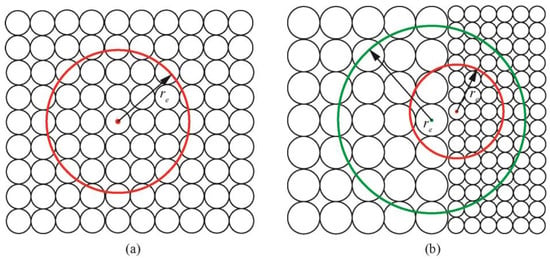
Figure 1.
Schematic diagram of MPS methods: (a) the traditional MPS method, (b) the multi-resolution MPS method.
Firstly, the volume of particle i, i.e., Vi, is defined as:
where li is the particle spacing of i, and d is the space dimension.
Then, the effective radius of particle i, re,i, can be redefined as:
where the constant k is set to 2.9 in the present work.
As shown in Figure 2, four different scenarios exist for the cutoff region of particle i in the context of multi-resolution MPS modeling. Accordingly, the kernel function between particle i and its neighboring particle j is defined as follows.
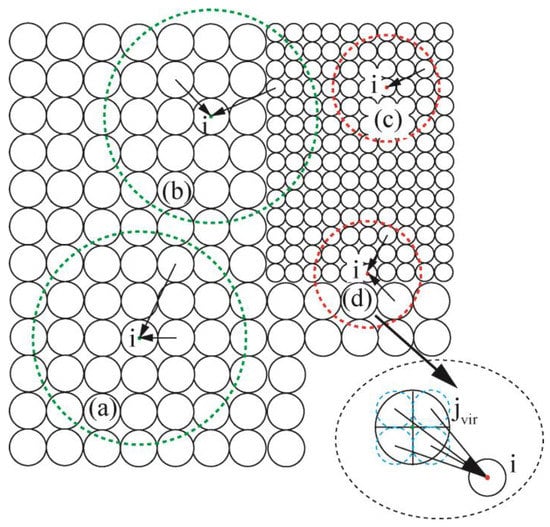
Figure 2.
Particle interactions for multi-resolution MPS modeling: (a) interactions between coarse particles, (b) interactions between a coarse particle and particles of different radii, (c) interactions between fine particles, (d) interactions between a fine particle and particles of different radii, where a large particle j will virtually be split into small particles jvir.
- (1)
- When , i.e., for scenarios (a), (b), and (c), the kernel function can be expressed as:
- (2)
- When , i.e., for scenario (d), the coarse particle j will be divided into small virtual particles, where there are four virtual particles in two dimensions (see Figure 2 (d)), and eight virtual particles in three dimensions, hypothetically. The coordinates of the eight small virtual particles in the 3D problem are , where vir = 1, 2, …8.
As a result, the expression of the kernel function is given as:
with
where and .
In consideration of the aforementioned kernel functions, the particle number density for particle i can be redefined as:
Accordingly, the pressure gradient term and the viscosity term take the following expressions.
- (1)
- When , i.e., for scenarios (a), (b), and (c), the expressions are given as:
- (2)
- When , i.e., for scenario (d), the two terms are rewritten as:
In summary, the final expressions of the pressure gradient term and the viscosity term are given as:
The other formulations, including those for fractional step calculations and the freesurface detections, are the same as those of the traditional MPS method.
3.2. Improved Bucket Sort Algorithm
Normally, the so-called bucket sort algorithm [65] is employed to account for efficient searching of neighboring particles for a given MPS particle. In view of the multi-resolution characteristics of fluid simulations, the bucket sort algorithm is further improved, which mainly involves three steps.
- (1)
- Domain decomposition. In this step, the domain to be solved is decomposed into a series of cells; see the rectangular cells (C1 to C9) with purple lines in Figure 3. A common treatment in the traditional MPS method is to set the cell size to be equal to the effective radius re for convenience. In the present work, the cell size is set to be the maximum effective radius, i.e., remax = klmax, where k = 2.9 and lmax is the largest particle spacing in the simulation model.
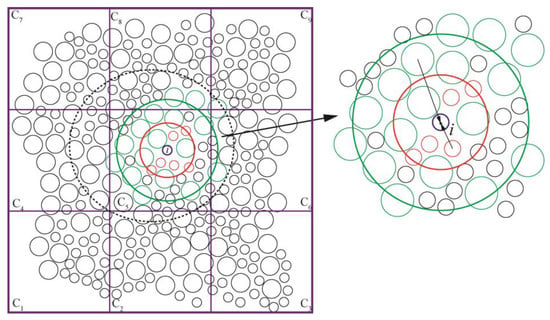 Figure 3. Schematic diagram of the improved bucket sort algorithm.
Figure 3. Schematic diagram of the improved bucket sort algorithm. - (2)
- Particle positioning. The purpose of this step is to map all the particles into the decomposed cells according to their positions, and the mapped particles within each cell are recorded.
- (3)
- Potential pairs. The aim of this step is to find all the potential particles that fall within the influence domain of a given particle. This is achieved by looping over the decomposed cells, and performing distance judgments for each particle in a given cell with other particles in the same cell and neighboring cells. Take particle i in cell C5 as an example. If lj > li, the influence radius of particle i is klj (see the green circle in Figure 3). In this case, particles i and j will be treated as a potential pair when Equation (24) is satisfied. However, the influence radius becomes kli (see the red circle in Figure 3) when lj ≤ li, and particles i and j will be treated as a potential pair if Equation (25) is satisfied. In this case, all the neighbor particles of i are found.
4. Multi-Resolution MPS/FEM Coupling Method
The present work is interested in the development of an MPS/FEM coupling method for FSI simulations on the basis of the multi-resolution MPS scheme developed in Section 3. A popular and common strategy to couple the MPS and the FEM that are, respectively, employed to account for fluid flows and structural deformation is to seek recourse to boundary models. In this regard, this work advocates the use of a ghost cell boundary model [18] that was newly proposed to provide an easy and natural treatment for wall boundaries of complicated shapes. However, this boundary model is currently only applicable to particles of a single resolution. In light of this, the capability of the boundary model is further enhanced to aid the development of an efficient multi-resolution MPS/FEM coupling method.
4.1. Improved Boundary Model
For a given particle i near the wall boundary, its movement is affected by both the fluid flows and the surrounding wall boundary. The main idea of the ghost cell boundary model is to consider particle–particle interactions via the traditional version of the MPS model, and develop an integral version for particle–wall interactions. As a result, the particle number density, the pressure gradient term, and the viscosity term are calculated as [18,23]:
where in the multi-resolution MPS modeling, the contributions from the fluids, i.e., nifluid, , and , can be yielded via Equations (16), (22) and (23), respectively. While niwall, , and are calculated by the ghost cell boundary model. Taking the particle number density as an example, the affect from the wall boundary is calculated by an integral version of the MPS model, and is simplified to the following form:
where xc is the position vector of the integration point in the physical coordinate system of ghost cell c and . Sc is the area of the ghost cell in a 2D problem (note: Sc should be the volume of the ghost cell in 3D). By using this model, the cell size must be approximate to or smaller than the initial particle spacing to guarantee the accuracy, which is not convenient for the multi-resolution MPS method. In this case, the GCB model is improved. As shown in Figure 4, interactions between fluid particle i and boundary cell c take the following situations.
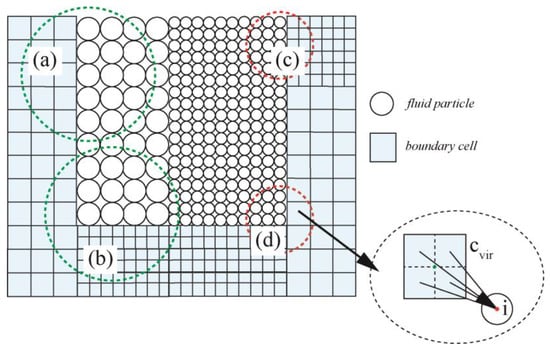
Figure 4.
Schematic diagram of the improved boundary model for multi-resolution MPS modeling: (a) interactions between a coarse particle with a coarse boundary cell, (b) interactions between a coarse particle and boundary cells of different sizes, (c) interactions between a fine particle with a small boundary cell, and (d) interactions between a fine particle and cells of different sizes, where a large cell c will virtually be split into small cells cvir.
- (1)
- When li ≥ lc, i.e., for scenarios (a), (b), and (c) in Figure 4, the expression for the kernel function can be expressed as:where . Here, xc is the position vector of the integration point in the physical coordinate system of cell c, and Vc = (lc)d is the volume of cell c. One can refer to the expressions of xc and Vc in [18].
- (2)
- When li < lc, a given large cell will be divided into several small cells, with four small cells in two dimensions (see scenario (d) in Figure 4) and eight small cells in three dimensions, hypothetically. The coordinates of these small ghost cells in a 3D problem are , where vir = 1, 2, …8. In this case, the kernel function is written as:
The particle number density contributed to particle i from the wall boundary is written as:
Accordingly, the pressure gradient term and the viscosity term take the following equations.
- (1)
- When li ≥ lc:
- (2)
- When li < lc:
According to the equations above, one can obtain the final expressions of the pressure gradient term and the viscosity term from the wall boundary to the fluid domain as follows.
It is worth noting that the searching process of neighboring cells for a given particle is similar to that described in Section 3.2.
4.2. Coupling of Multi-Resolution MPS and FEM
In the fluid–structure coupling scheme, the fluid analysis and structure calculations are implemented separately. As shown in Figure 5, neighbor sorting is performed firstly to find potential contact pairs among the fluid particles and finite elements, where multi-resolution particles and block finite elements are adopted in this work. The internal force caused by structure deformation is calculated subsequently. External forces acting on the structure include gravity, contact force, and pressure coming from the fluid part. After the above calculation, the node information is updated. As for fluid particles, the viscosity term and the external force will be implemented to obtain the intermediate particle information. Then, the pressure gradient term is solved to update the particle information finally. During the calculation, the deformable geometrical shapes of structures can be viewed as the moving wall boundaries of fluid flows. In our coupling method, on one hand, the contribution from structures to fluids is easily calculated with the aid of the improved boundary model addressed in Section 3.2; on the other hand, the effect from fluids to structures takes the following form:
where is the mass of particle i interacting with cell c. and are given as:

Figure 5.
Schematic diagram of the fluid–structure interaction solver.
5. Numerical Examples
In this section, the effectiveness and robustness of the developed multi-resolution MPS method and the improved boundary model are validated via two numerical examples, i.e., the hydrostatic problem, and the water entry problem. On this basis, the capacity and effectiveness of our developed multi-resolution MPS/FEM coupling method are demonstrated via the dam break problem with an elastic obstacle.
5.1. Hydrostatic Problem
The first numerical example used in the present work for verification is a well-known hydrostatic benchmark problem [66]. As shown in Figure 6, the geometric dimensions of the water tank are 1000 mm × 1000 mm, whereas the thickness of the tank is 100 mm. Three cases. i.e., cases 1, 2, and 3, are simulated to validate the effectiveness of the multi-resolution MPS method. Uniform fine particles are adopted in case 1 for comparison. In case 2, the upper center part of the fluid area is discretized into high-resolution particles, whereas low-resolution particles are used elsewhere. In case 3, three levels of particles are applied, where the finest particles are used in the orange region, the middle-sized particles are applied in the green region, and the largest particles are used elsewhere. Figure 7 displays simulation models of the three cases, where the smallest particle spacing of 10.0 mm is used in case 1 and the particle number is 100,000. The particle spacings for the high- and low-resolution particles in case 2 are, respectively, 10.0 mm and 20.0 mm, and the corresponding particle numbers are 24,000 and 9500. In case 3, the particle spacings are 10.0 mm, 15.0 mm, and 20.0 mm for high-, middle-, and low-resolution particles, respectively, and the corresponding numbers of particles are 7500, 5180, and 9500. As mentioned before, the boundary cell size is the same as the maximum particle size in every simulation model, and the total numbers of boundary cells are 81,648, 21,978, and 21,978, respectively. Detailed information of the three cases is given in Table 1, and te corresponding simulation parameters are listed in Table 2.

Figure 6.
Geometric dimensions of the hydrostatic problem considered in the present work.
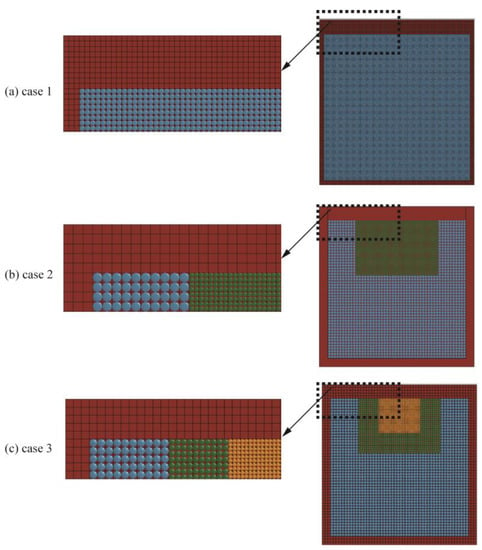
Figure 7.
Simulation models of the hydrostatic problem: (a) uniform particle distribution model with the particle spacing of 10.0 mm; (b) two-layer particle distribution mode with the particle spacings of 10.0 mm and 20.0 mm; (c) three-layer particle distribution mode with the particle spacings of 10.0 mm, 15.0 mm, and 20.0 mm.

Table 1.
Detailed information of the three cases in the hydrostatic problem.

Table 2.
Simulation parameters of the hydrostatic problem.
Figure 8 shows the pressure nephogram of the three cases at t = 10 s. It can be seen from this figure that a regular and uniform pressure distribution is yielded. A relatively smooth pressure distribution is also obtained at the interface of different particle sizes in cases 2 and 3. It is obvious that the shape of the high-resolution region in Figure 8b is different from the original shape shown in Figure 7b, which was also observed in [66]. However, the difference in the present work is more obvious than that in [66], because the three-dimensional problem is simulated here and particles are packing in the three directions. When it comes to case 3, the shapes of the high- and middle-resolution regions are similar to the one shown in Figure 7c, which indicates that the smooth transition of particle size may improve the particle distribution at the interface.
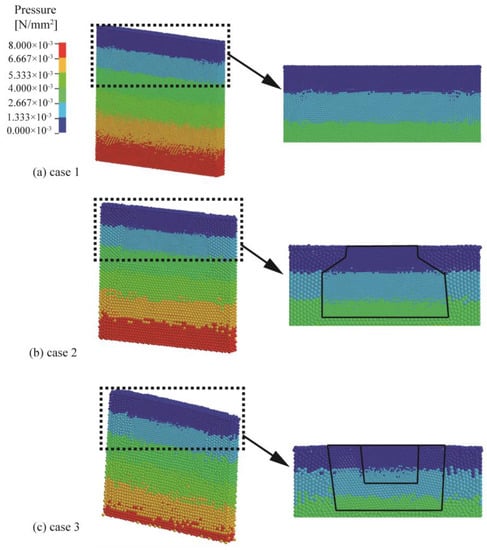
Figure 8.
Pressure nephograms of the three cases at t = 10 s.
Figure 9 gives the kinetic energy predicted by the three cases, where MgH means the gravitational potential energy of the water in the initial configuration. It can be seen from this figure that the kinetic energy of the three cases increases rapidly at the initial stage, then falls down and reaches a very small value soon after. It can be concluded that the disturbance caused by different particle sizes is not large and can be reduced quickly. Furthermore, in this example, the computational times of cases 1, 2, and 3 are 102 h and 6 min, 65 h and 35 min, and 40 h and 58 min, respectively, where the computational costs of cases 2 and 3 are reduced by 35.8% and 59.9% compared to case 1. These numerical results demonstrate the effectiveness and accuracy of the proposed multi-resolution MPS method and the improved boundary model.

Figure 9.
Kinetic energy predicted by the three cases.
5.2. Water Entry Problem
This section considers a common water entry problem [51,67,68] for further numerical verification. As displayed in Figure 10, the dimensions of the water tank are 2.0 m × 0.3 m × 0.3 m, and the radius of the rigid circular cylinder is 55 mm. Initially, the center of the rigid circular cylinder is placed at a position that is 1.0 m to the left boundary of the tank and 0.5 m above the water level. The cylinder falls down freely under gravity from the beginning, and then strikes the water at about 0.301 s with an entry velocity of 2.955 m/s. Here, the rigid circular cylinder is only allowed to move in the vertical direction.
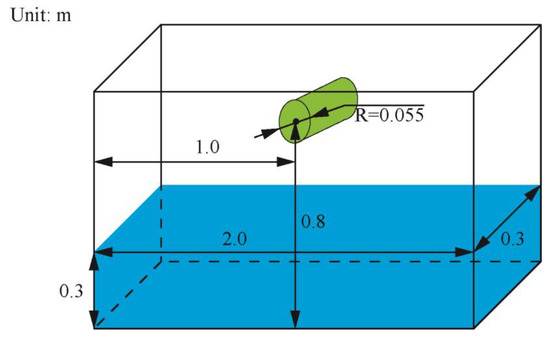
Figure 10.
Schematic diagram of the water entry problem.
Figure 11 shows three simulation models of the water entry problem. In Figure 11a, the fluid area is described via particles with a uniform particle spacing of 10.0 mm and the number of particles is 180,000, while the cell size of the water tank is 10.0 mm and the cell number is 149,688. In Figure 11b, the water tank is discretized into cells with sizes of 20.0 mm and the cell number is 70,000. In order to well describe the impacted fluid’s behavior, the impacted fluid domain is described via the finest particles, with the particle spacing of 10.0 mm and the particle number of 54,000; relatively coarser particles are used for the intermediate domain, with the particle spacing of 20.0 mm, and the particle number is 4500; for the domain far away from the impacted region, the coarsest particles with the particle spacing of 30.0 mm are used, and the particle number is 2000. For the third model, as shown in Figure 11c, the fluid domain is described via particles with a uniform particle spacing of 30.0 mm and the number of particles is 6700, while the cell size for the water tank is 30.0 mm and the cell number is 26,922. It is worth noting that in all the three simulation models, in order to ensure numerical accuracy, the rigid circular cylinder is discretized into cells with a size close to 10.0 mm, and the cell number is 4200. The corresponding simulation parameters are given in Table 3 and Table 4.
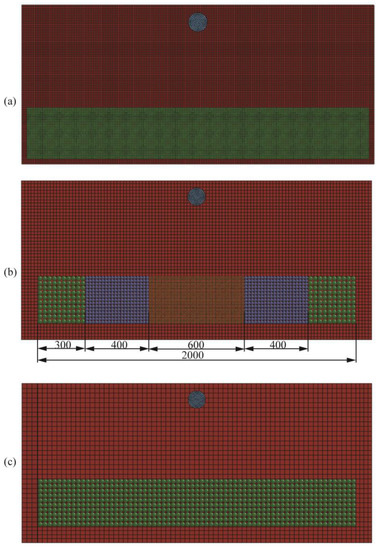
Figure 11.
Simulation models of the water entry problem: (a) fine particle model, (b) multi-resolution particle model, (c) coarse particle model.

Table 3.
Simulation models of the water entry problem.

Table 4.
Simulation parameters for the water entry problem [51].
Snapshots of the free-surface profile and pressure distribution are shown in Figure 12. It can be seen from this figure that the circular cylinder impacts the water level and causes a high pressure distribution under the circular cylinder at about 0.31 s. As the circular cylinder continues to move down, fluid particles splash to the sides of the cylinder, and a jet flow can be observed. It can also be observed that the result calculated via the multi-resolution model is in good agreement with that obtained via the fine particle model, and is much more natural than the one computed via the coarse particle model. Otherwise, a smooth transition between particles of different resolutions can be observed in Figure 12b.
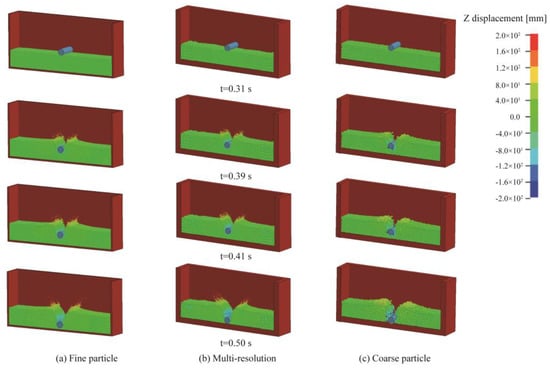
Figure 12.
Snapshots of the free surface profile and z displacement of the water entry problem at different time instants: (a) Fine particle model, (b) Multi-resolution particle model, (c) Coarse particle model.
The penetration depth versus time curves of the circular cylinder are shown in Figure 13, where the time axis is set from the initial impact moment. In this figure, the purple line indicates the result calculated via our developed model, the red and green lines indicate the results calculated, respectively, via the coarse and fine particle models, the yellow and blue lines indicate the results published, respectively, in [51,68], and the black rectangle indicates the experimental data [67]. Greenhow and Lin put a question mark on one of the experimental values (see Figure 13) because it obviously deviates from the other data. Ignoring this problem datum, our numerical result is found to be in good agreement with the experimental data in [67] and other simulation results in [51,68]. In addition, the result of the developed multi-resolution particle model agrees well with that of the fine particle model, where a large deviation is observed from the result of the coarse particle model. In addition to that, the computational cost of the fine particle method is about five times higher than that of the multi-resolution MPS method. With this numerical example, the effectiveness and accuracy of the developed multi-resolution MPS method and the improved boundary model are verified.
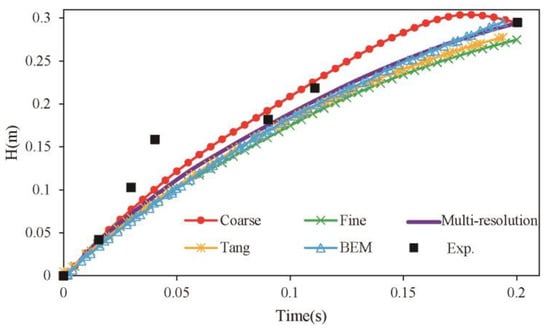
Figure 13.
Comparisons of penetration depth versus time curves of the circular cylinder among the presented multi-resolution model, coarse particle model, fine particle model, experimental data [57], boundary element method [58], and Tang’s result [44].
5.3. Dam Break with an Elastic Obstacle
The purpose of this section is to demonstrate the effectiveness and accuracy of the proposed multi-resolution MPS/FEM coupling method via another benchmark test, i.e., the dam break problem with an elastic obstacle [20,23,69]. As shown in Figure 14, the dimensions of the tank, the water column, and the elastic obstacle are 4 L × L × 4 L, L × L × 2 L, and s × L × h, respectively. Here, L is 146 mm, s is 12 mm, and h is 80 mm.
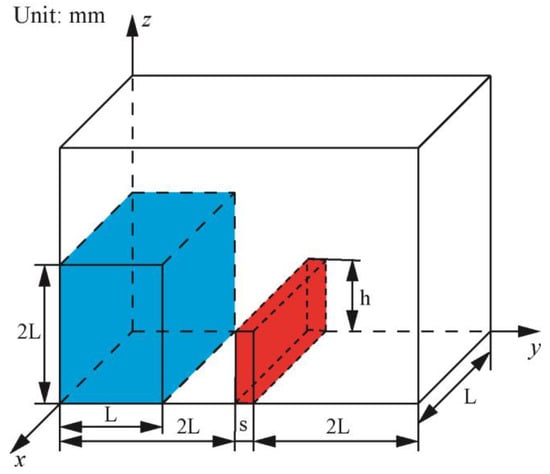
Figure 14.
Schematic diagram of the dam break problem with an elastic obstacle.
Figure 15 shows the simulation model of the dam break test with an elastic obstacle, where the particle spacings of the high- and low-resolution domains are 4.06 mm and 8.11 mm, respectively. The numbers of high- and low-resolution particles are, respectively, 46,656 and 5832. In order to well describe the structural deformation and FSI phenomena, the mesh/cell sizes for the elastic obstacle and its surrounding wall boundaries are set to be close to the particle spacing of the high-resolution domain. After discretization, the numbers of boundary cells and finite elements are 104,204 and 2220, respectively. As for the other simulation parameters, they are listed in Table 5.
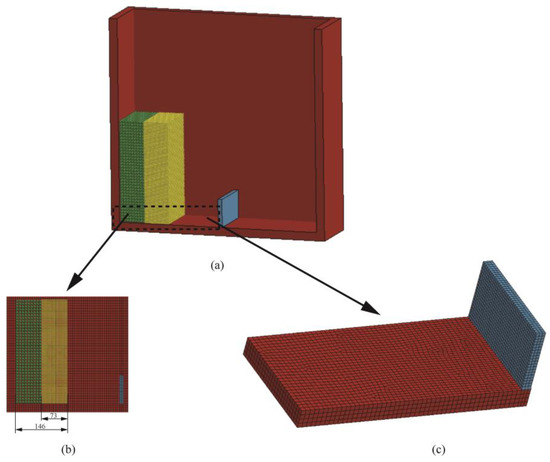
Figure 15.
Simulation model of the dam break problem with an elastic obstacle: (a) the whole model, (b) the enlargement of fluid particle model, and (c) the enlargement of the elastic obstacle.

Table 5.
Simulation parameters of the dam break test with an elastic obstacle [20].
In Figure 16, one can observe the flow patterns and pressure nephograms of the benchmark test at time instances t = 0.12, 0.36, 0.60, 0.84 s. It can be seen that the water column firstly collapses under the action of gravity, and hits the elastic obstacle at about 0.15 s, followed by the bending of the obstacle; subsequently, the fluid falls down after hitting the wall on the right-hand side, and strikes the obstacle again; the obstacle sways due to the FSI effect. In addition, the area close to the elastic obstacle is locally enlarged at the top left corner of each sub-figure, where one can clearly see the interaction between particles and finite elements. It is worth noting that particles around the elastic structure are almost only high-resolution particles, which guarantees the computational accuracy for the modeling of the FSI phenomenon.
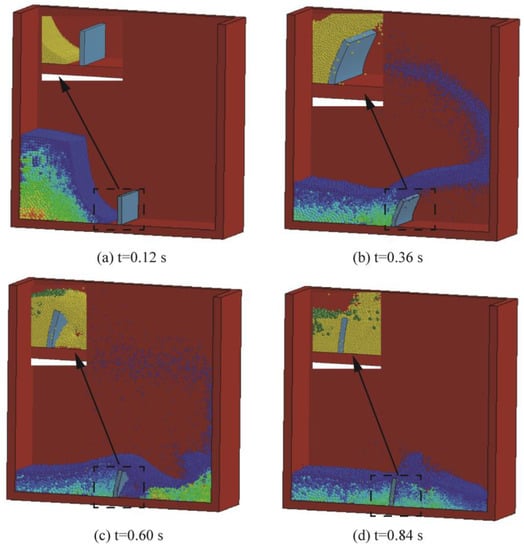
Figure 16.
Pressure nephograms of the dam break problem.
As shown in Figure 17, we plot the y displacement history of the free end of the obstacle, and compare it with an existing numerical result calculated by the single-resolution MPS/FEM method [23]. Although there are slight differences, the two curves are in good consistent with each other. In Figure 18, the simulation result is further compared with numerical results from the literature [20,69,70]. One can see from this figure that our displacement history curve agrees well with existing numerical data. With those flow profiles and comparisons, the effectiveness of our proposed multi-resolution MPS/FEM coupling method are verified. Still, one should be careful about the modeling of the fluid area; if the high-resolution area is not large enough, the simulation accuracy can not be guaranteed. Conversely, if the high-resolution area is too large, the improvement of the computational efficiency may not be obvious.

Figure 17.
Comparison between the simulation results obtained from the present multi-resolution MPS/FEM method and the single-resolution MPS/FEM method in [23].
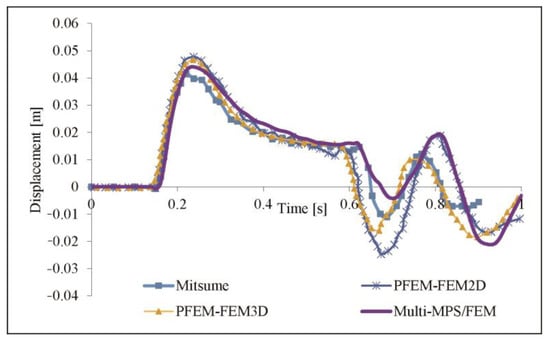
Figure 18.
Comparison of our simulation result with existing numerical results in terms of y displacement history of the free end of the obstacle. In this figure, “Multi-MPS/FEM” means the numerical result calculated via the multi-resolution MPS/FEM coupling method; “Mitsume”, “PFEM-FEM2D”, and “PFEM-FEM3D” are the numerical results from the literature [20,69,70].
6. Conclusions
This work has developed a multi-resolution MPS/FEM method for efficient FSI simulation. To achieve this end, a multi-resolution MPS method that, respectively, discretizes the fluid domains of interest and the rest of the domains into fine and coarse particles is developed. The main appeal of this method is that the computational efficiency for fluid simulations is dramatically boosted, while being robust and easy to implement. The MPS kernel function is modified to guarantee stable calculations between particles of different resolutions, and a searching method based on the bucket sort algorithm is developed for the fast determination of neighboring particles. The multi-resolution MPS method is easily coupled with the FEM with the aid of an improved ghost cell boundary model. As for verifications, two benchmark numerical tests, i.e., the hydrostatic problem and the water entry problem, are first performed to demonstrate the effectiveness and accuracy of the developed multi-resolution MPS method and the improved boundary model. Finally, the widely used dam break problem with an elastic obstacle is carried out for numerical verification of our developed multi-resolution MPS/FEM coupling method. The numerical results show that our proposed method is very effective for FSI applications.
Large-scale FSI problems, such as tsunamis and the flash floods, are easily encountered in real life. Even though our developed MPS/FEM coupling method can be an efficient tool to reproduce FSI phenomena, it still requires considerable computational cost for our method to solve large-scale problems. In order to further improve the computational efficiency, the multi-GPU based parallel computing technique is going to be applied in the near future. The developed coupling method will be accelerated with CUDA Fortran, and the application of the parallelized coupling algorithm will be extended to multi-body floating wind turbine problems.
Author Contributions
Conceptualization, Z.Z. and S.C.; methodology, Z.Z., N.M. and S.C.; software, Z.Z.; validation, Z.Z.; investigation, Z.Z. and J.C.; writing—original draft preparation, Z.Z., S.Z., J.C., N.M. and S.C.; writing—review and editing, Z.Z. and S.C.; visualization, S.Z.; funding acquisition, Z.Z. and S.C. All authors have read and agreed to the published version of the manuscript.
Funding
This research was funded by Guangdong Basic and Applied Basic Research Foundation (nos. 2021A1515110390 and 2022A1515011155), the Innovation Group Project of Southern Marine Science and Engineering Guangdong Laboratory (Zhuhai) (no. SML2022016), the Natural Science Foundation of Shandong Province (no. ZR2022QA044), and the Young Innovative Talents Introduction & Cultivation Program for Colleges and Universities of Shandong Province (granted by the Department of Education of Shandong Province; sub-title: Innovative Research Team of High Performance Integrated Device).
Institutional Review Board Statement
Not applicable.
Informed Consent Statement
Not applicable.
Conflicts of Interest
The authors declare no conflict of interest.
References
- Korobenko, A.; Yan, J.; Gohari, S.; Sarkar, S.; Bazilevs, Y. FSI simulation of two back-to-back wind turbines in atmospheric boundary layer flow. Comput. Fluids 2017, 158, 167–175. [Google Scholar] [CrossRef]
- Young, Y.L. Fluid-structure interaction analysis of flexible composite marine propellers. J. Fluids Struct. 2008, 24, 799–818. [Google Scholar] [CrossRef]
- Tian, F.B.; Dai, H.; Luo, H.; Doyle, J.F.; Rousseau, B. Fluid-structure interaction involving large deformations: 3D simulations and applications to biological systems. J. Comput. Phys. 2014, 258, 451–469. [Google Scholar] [CrossRef] [PubMed]
- Bazilevs, Y.; Takizawa, K.; Tezduyar, T.E. Computational Fluid-Structure Interaction: Methods and Applications; John Wiley & Sons: Hoboken, NJ, USA, 2013. [Google Scholar]
- Axisa, F.; Antunes, J. Modelling of Mechanical Systems: Fluid-Structure Interaction; Elsevier: Amsterdam, The Netherlands, 2006; Volume 3. [Google Scholar]
- Espinosa, H.D.; Lee, S.; Moldovan, N. A novel fluid structure interaction experiment to investigate deformation of structural elements subjected to impulsive loading. Exp. Mech. 2006, 46, 805–824. [Google Scholar] [CrossRef]
- Fossa, M.; Rizzo, C.M.; Tani, G.; Viviani, M. Simulations of a sloshing experiment by FEM CFD and FEM FSI approaches. In The Twenty-second International Offshore and Polar Engineering Conference; International Society of Offshore and Polar Engineers: Mountain View, CA, USA, 2012; pp. 530–537. [Google Scholar]
- Zhang, L.; Guo, Y.; Wang, W. FEM simulation of turbulent flow in a turbine blade passage with dynamical fluid-structure interaction. Int. J. Numer. Methods Fluids 2009, 61, 1299–1330. [Google Scholar] [CrossRef]
- Ma, J.; Wang, Z.; Young, J.; Lai, J.C.; Sui, Y.; Tian, F.B. An immersed boundary-lattice Boltzmann method for fluid-structure interaction problems involving viscoelastic fluids and complex geometries. J. Comput. Phys. 2020, 415, 109487. [Google Scholar] [CrossRef]
- Zhu, Y.; Wei, Y.; Wang, Z.; Wang, R.; Wu, C.; Chen, J.; Tong, J. Numerical simulation for deformation characteristic of tea shoot under negative pressure guidance by the immersed boundary–lattice Boltzmann method. J. Comput. Sci. 2022, 65, 101882. [Google Scholar] [CrossRef]
- Hui, D.; Wang, Z.; Cai, Y.; Wu, W.; Zhang, G.; Liu, M. An immersed boundary-lattice Boltzmann method with hybrid multiple relaxation times for viscoplastic fluid-structure interaction problems. Appl. Ocean Res. 2022, 119, 103023. [Google Scholar] [CrossRef]
- Khayyer, A.; Gotoh, H.; Falahaty, H.; Shimizu, Y. An enhanced ISPH-SPH coupled method for simulation of incompressible fluid-elastic structure interactions. Comput. Phys. Commun. 2018, 232, 139–164. [Google Scholar] [CrossRef]
- Han, L.; Hu, X. SPH modeling of fluid-structure interaction. J. Hydrodyn. 2018, 30, 62–69. [Google Scholar] [CrossRef]
- Antoci, C.; Gallati, M.; Sibilla, S. Numerical simulation of fluid-structure interaction by SPH. Comput. Struct. 2007, 85, 879–890. [Google Scholar] [CrossRef]
- Zhang, H.; Zhang, Z.; He, F.; Liu, M. Numerical investigation on the water entry of a 3D circular cylinder based on a GPU-accelerated SPH method. Eur. J. Mech.-B/Fluids 2022, 94, 1–16. [Google Scholar] [CrossRef]
- Zhang, Z.; Shu, C.; Khalid, M.S.U.; Yuan, Z.; Liu, W. Investigations on the hydroelastic slamming of deformable wedges by using the smoothed particle element method. J. Fluids Struct. 2022, 114, 103732. [Google Scholar] [CrossRef]
- Koshizuka, S.; Oka, Y. Moving-particle semi-implicit method for fragmentation of incompressible fluid. Nucl. Sci. Eng. 1996, 123, 421–434. [Google Scholar] [CrossRef]
- Zheng, Z.; Duan, G.; Mitsume, N.; Chen, S.; Yoshimura, S. A novel ghost cell boundary model for the explicit moving particle simulation method in two dimensions. Comput. Mech. 2020, 66, 87–102. [Google Scholar] [CrossRef]
- Hwang, S.C.; Khayyer, A.; Gotoh, H.; Park, J.C. Development of a fully Lagrangian MPS-based coupled method for simulation of fluid-structure interaction problems. J. Fluids Struct. 2014, 50, 497–511. [Google Scholar] [CrossRef]
- Mitsume, N.; Yoshimura, S.; Murotani, K.; Yamada, T. MPS-FEM partitioned coupling approach for fluid-structure interaction with free surface flow. Int. J. Comput. Methods 2014, 11, 1350101. [Google Scholar] [CrossRef]
- Zhang, Y.; Wan, D. MPS-FEM coupled method for sloshing flows in an elastic tank. Ocean Eng. 2018, 152, 416–427. [Google Scholar] [CrossRef]
- Rao, C.; Wan, D. Numerical study of the wave-induced slamming force on the elastic plate based on MPS-FEM coupled method. J. Hydrodyn. 2018, 30, 70–78. [Google Scholar] [CrossRef]
- Zheng, Z.; Duan, G.; Mitsume, N.; Chen, S.; Yoshimura, S. An explicit MPS/FEM coupling algorithm for three-dimensional fluid-structure interaction analysis. Eng. Anal. Bound. Elem. 2020, 121, 192–206. [Google Scholar] [CrossRef]
- Zhang, G.; Zha, R.; Wan, D. MPS-FEM coupled method for 3D dam-break flows with elastic gate structures. Eur. J. Mech.-B/Fluids 2022, 94, 171–189. [Google Scholar] [CrossRef]
- Long, T.; Hu, D.; Wan, D.; Zhuang, C.; Yang, G. An arbitrary boundary with ghost particles incorporated in coupled FEM-SPH model for FSI problems. J. Comput. Phys. 2017, 350, 166–183. [Google Scholar] [CrossRef]
- Yang, Q.; Jones, V.; McCue, L. Free-surface flow interactions with deformable structures using an SPH-FEM model. Ocean Eng. 2012, 55, 136–147. [Google Scholar] [CrossRef]
- Shakibaeinia, A.; Jin, Y.C. A weakly compressible MPS method for modeling of open-boundary free-surface flow. International J. Numer. Methods Fluids 2010, 63, 1208–1232. [Google Scholar] [CrossRef]
- Nabian, M.A.; Farhadi, L. MR-WC-MPS: A multi-resolution WC-MPS method for simulation of free-surface flows. Water 2019, 11, 1349. [Google Scholar] [CrossRef]
- Shibata, K.; Koshizuka, S.; Matsunaga, T.; Masaie, I. The overlapping particle technique for multi-resolution simulation of particle methods. Comput. Methods Appl. Mech. Eng. 2017, 325, 434–462. [Google Scholar] [CrossRef]
- Mitsume, N.; Yamada, T.; Yoshimura, S. Parallel analysis system for free-surface flow using MPS method with explicitly represented polygon wall boundary model. Comput. Part. Mech. 2020, 7, 279–290. [Google Scholar] [CrossRef]
- Murotani, K.; Koshizuka, S.; Tamai, T.; Shibata, K.; Mitsume, N.; Yoshimura, S.; Tanaka, S.; Hasegawa, K.; Nagai, E.; Fujisawa, T. Development of hierarchical domain decomposition explicit MPS method and application to large-scale tsunami analysis with floating objects. J. Adv. Simul. Sci. Eng. 2014, 1, 16–35. [Google Scholar] [CrossRef]
- Zheng, Z.; Zang, M.; Chen, S.; Zeng, H. A GPU-based DEM-FEM computational framework for tire-sand interaction simulations. Comput. Struct. 2018, 209, 74–92. [Google Scholar] [CrossRef]
- Wen, X.; Chen, X.; Wan, D. Numerical simulation of multi-layer-liquid sloshing by multiphase MPS-GPU method. In International Conference on Offshore Mechanics and Arctic Engineering; American Society of Mechanical Engineers: New York, NY, USA, 2020; Volume 84409, p. V008T08A002. [Google Scholar]
- Basit, M.A.; Tian, W.; Chen, R.; Basit, R.; Qiu, S.; Su, G. Investigation of single bubble behavior under rolling motions using multiphase MPS method on GPU. Nucl. Eng. Technol. 2021, 53, 1810–1820. [Google Scholar] [CrossRef]
- Feldman, J.; Bonet, J. Dynamic refinement and boundary contact forces in SPH with applications in fluid flow problems. Int. J. Numer. Methods Eng. 2007, 72, 295–324. [Google Scholar] [CrossRef]
- Reyes L´opez, Y.; Roose, D.; Recarey Morfa, C. Dynamic particle refinement in SPH: Application to free surface flow and non-cohesive soil simulations. Comput. Mech. 2013, 51, 731–741. [Google Scholar] [CrossRef]
- Vacondio, R.; Rogers, B.; Stansby, P.K.; Mignosa, P.; Feldman, J. Variable resolution for SPH: A dynamic particle coalescing and splitting scheme. Comput. Methods Appl. Mech. Eng. 2013, 256, 132–148. [Google Scholar] [CrossRef]
- Chen, X.; Sun, Z.G.; Liu, L.; Xi, G. Improved MPS method with variable-size particles. Int. J. Numer. Methods Fluids 2016, 80, 358–374. [Google Scholar] [CrossRef]
- Barcarolo, D.A.; Le Touz´e, D.; Oger, G.; De Vuyst, F. Adaptive particle refinement and derefinement applied to the smoothed particle hydrodynamics method. J. Comput. Phys. 2014, 273, 640–657. [Google Scholar] [CrossRef]
- Hu, L.; HongFu, Q.; FuZhen, C.; Chao, S. A particle refinement scheme with hybrid particle interacting technique for multi-resolution SPH. Eng. Anal. Bound. Elem. 2020, 118, 108–123. [Google Scholar] [CrossRef]
- Sun, P.; Zhang, A.M.; Marrone, S.; Ming, F. An accurate and efficient SPH modeling of the water entry of circular cylinders. Appl. Ocean Res. 2018, 72, 60–75. [Google Scholar] [CrossRef]
- Sun, P.N.; Le Touze, D.; Oger, G.; Zhang, A.M. An accurate FSI-SPH modeling of challenging fluid-structure interaction problems in two and three dimensions. Ocean Eng. 2021, 221, 108552. [Google Scholar] [CrossRef]
- Zhang, K.; Sun, Y.J.; Sun, Z.G.; Wang, F.; Chen, X.; Xi, G. An efficient MPS refined technique with adaptive variable-size particles. Eng. Anal. Bound. Elem. 2022, 143, 663–676. [Google Scholar] [CrossRef]
- Tang, Z.Y.; Zhang, Y.L.; Wan, D.C. Numerical simulation of 3D free surface flows by overlapping MPS. J. Hydrodyn. Ser B 2016, 28, 306–312. [Google Scholar] [CrossRef]
- Chiron, L.; Oger, G.; De Leffe, M.; Le Touz´e, D. Analysis and improvements of adaptive particle refinement (APR) through CPU time, accuracy and robustness considerations. J. Comput. Phys. 2018, 354, 552–575. [Google Scholar] [CrossRef]
- Yamada, D.; Imatani, T.; Shibata, K.; Maniwa, K.; Obara, S.; Negishi, H. Application of improved multiresolution technique for the MPS method to fluid lubrication. Comput. Part. Mech. 2022, 9, 421–441. [Google Scholar] [CrossRef]
- Lastiwka, M.; Basa, M.; Quinlan, N.J. Permeable and non-reflecting boundary conditions in SPH. Int. J. Numer. Methods Fluids 2009, 61, 709–724. [Google Scholar] [CrossRef]
- Oger, G.; Doring, M.; Alessandrini, B.; Ferrant, P. Two-dimensional SPH simulations of wedge water entries. J. Comput. Phys. 2006, 213, 803–822. [Google Scholar] [CrossRef]
- Shibata, K.; Koshizuka, S.; Masaie, I. Cost reduction of particle simulations by an ellipsoidal particle model. Comput. Methods Appl. Mech. Eng. 2016, 307, 411–450. [Google Scholar] [CrossRef]
- Omidvar, P.; Stansby, P.K.; Rogers, B.D. Wave body interaction in 2D using smoothed particle hydrodynamics (SPH) with variable particle mass. Int. J. Numer. Methods Fluids 2012, 68, 686–705. [Google Scholar] [CrossRef]
- Tang, Z.; Wan, D.; Chen, G.; Xiao, Q. Numerical simulation of 3D violent free-surface flows by multi-resolution MPS method. J. Ocean Eng. Mar. Energy 2016, 2, 355–364. [Google Scholar] [CrossRef]
- Mitsume, N.; Yoshimura, S.; Murotani, K.; Yamada, T. Improved MPS-FE fluidstructure interaction coupled method with MPS polygon wall boundary model. CMES-Comput. Model. Eng. Sci. 2014, 101, 229–247. [Google Scholar]
- Fourey, G.; Hermange, C.; Le Touz´e, D.; Oger, G. An efficient FSI coupling strategy between smoothed particle hydrodynamics and finite element methods. Comput. Phys. Commun. 2017, 217, 66–81. [Google Scholar] [CrossRef]
- Khayyer, A.; Shimizu, Y.; Gotoh, H.; Hattori, S. Multi-resolution ISPH-SPH for accurate and efficient simulation of hydroelastic fluid-structure interactions in ocean engineering. Ocean Eng. 2021, 226, 108652. [Google Scholar] [CrossRef]
- Khayyer, A.; Gotoh, H.; Shimizu, Y.; Nishijima, Y.; Nakano, A. 3D MPS-MPS coupled FSI solver for simulation of hydroelastic fluid-structure interactions in coastal engineering. J. Jpn. Soc. Civ. Eng. Ser B2 (Coast. Eng.) 2020, 76, 37–42. [Google Scholar] [CrossRef]
- Khayyer, A.; Tsuruta, N.; Shimizu, Y.; Gotoh, H. Multi-resolution MPS for incompressible fluid-elastic structure interactions in ocean engineering. Appl. Ocean Res. 2019, 82, 397–414. [Google Scholar] [CrossRef]
- Zhang, C.; Rezavand, M.; Hu, X. A multi-resolution SPH method for fluid-structure interactions. J. Comput. Phys. 2021, 429, 110028. [Google Scholar] [CrossRef]
- Sun, Y.; Xi, G.; Sun, Z. A generic smoothed wall boundary in multi-resolution particle method for fluid-structure interaction problem. Comput. Methods Appl. Mech. Eng. 2021, 378, 113726. [Google Scholar] [CrossRef]
- Chen, C.; Shi, W.K.; Shen, Y.M.; Chen, J.Q.; Zhang, A.M. A multi-resolution SPH-FEM method for fluid–structure interactions. Comput. Methods Appl. Mech. Eng. 2022, 401, 115659. [Google Scholar] [CrossRef]
- Akimoto, H. Numerical simulation of the flow around a planing body by MPS method. Ocean Eng. 2013, 64, 72–79. [Google Scholar] [CrossRef]
- Long, T.; Zhang, Z.; Liu, M. Multi-resolution technique integrated with smoothed particle element method (SPEM) for modeling fluid-structure interaction problems with free surfaces. Sci. China Phys. Mech. Astron. 2021, 64, 284711. [Google Scholar] [CrossRef]
- Wang, Z.; Sugiyama, T.; Matsunaga, T.; Koshizuka, S. A multi-resolution particle method with high order accuracy for solid-liquid phase change represented by sharp moving interface. Comput. Fluids 2022, 247, 105646. [Google Scholar] [CrossRef]
- Ng, K.C.; Alexiadis, A.; Ng, Y.L. An improved particle method for simulating fluid-structure interactions: The multi-resolution SPH-VCPM approach. Ocean Eng. 2022, 247, 110779. [Google Scholar] [CrossRef]
- Mitsume, N.; Yoshimura, S.; Murotani, K.; Yamada, T. Explicitly represented polygon wall boundary model for the explicit MPS method. Comput. Part. Mech. 2015, 2, 73–89. [Google Scholar] [CrossRef]
- Benson, D.J.; Hallquist, J.O. A single surface contact algorithm for the post-buckling analysis of shell structures. Comput. Methods Appl. Mech. Eng. 1990, 78, 141–163. [Google Scholar] [CrossRef]
- Tang, Z.; Zhang, Y.; Wan, D. Multi-resolution MPS method for free surface flows. Int. J. Comput. Methods 2016, 13, 1641018. [Google Scholar] [CrossRef]
- Greenhow, M.; Lin, W.M. Nonlinear-free surface effects: Experiments and theory. In Technical Report; Massachusetts Institute of Technology, Department of Ocean Engineering: Cambridge, MA, USA, 1983. [Google Scholar]
- Sun, H.; Faltinsen, O.M. Water impact of horizontal circular cylinders and cylindrical shells. Appl. Ocean Res. 2006, 28, 299–311. [Google Scholar] [CrossRef]
- Meduri, S.; Cremonesi, M.; Perego, U.; Bettinotti, O.; Kurkchubasche, A.; Oancea, V. A partitioned fully explicit lagrangian finite element method for highly nonlinear fluid-structure interaction problems. Int. J. Numer. Methods Eng. 2018, 113, 43–64. [Google Scholar] [CrossRef]
- Meduri, S.; Cremonesi, M.; Perego, U. An explicit lagrangian approach for 3D simulation of fluid-structure-interaction problems. In Proceedings of the 6th European Conference on Computational Mechanics (Solids, Structures and Coupled Problems) and 7th European Conference on Computational Fluid Dynamics, Glasgow, UK, 11–15 June 2018; pp. 2089–2098. [Google Scholar]
Disclaimer/Publisher’s Note: The statements, opinions and data contained in all publications are solely those of the individual author(s) and contributor(s) and not of MDPI and/or the editor(s). MDPI and/or the editor(s) disclaim responsibility for any injury to people or property resulting from any ideas, methods, instructions or products referred to in the content. |
© 2023 by the authors. Licensee MDPI, Basel, Switzerland. This article is an open access article distributed under the terms and conditions of the Creative Commons Attribution (CC BY) license (https://creativecommons.org/licenses/by/4.0/).